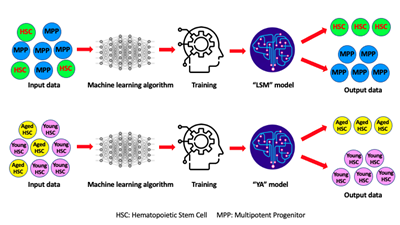 Distinguishing between various types of hematopoietic stem cells (HSCs)—the stem cells that give rise to various blood cells—and multipotent progenitors (MPPs) has long been a challenging but critical task. These cells are responsible for replenishing our blood supply, making their identification essential for both basic research and clinical applications such as bone marrow transplants. Previously, most separation methods involved intensive and complex techniques, staining cells with fluorescence-conjugated antibodies and using lasers to separate them.
Distinguishing between various types of hematopoietic stem cells (HSCs)—the stem cells that give rise to various blood cells—and multipotent progenitors (MPPs) has long been a challenging but critical task. These cells are responsible for replenishing our blood supply, making their identification essential for both basic research and clinical applications such as bone marrow transplants. Previously, most separation methods involved intensive and complex techniques, staining cells with fluorescence-conjugated antibodies and using lasers to separate them.
Scientists have developed a new method to differentiate these cells using deep learning techniques. Their findings were detailed in a paper titled “Deep Learning‑Based Predictive Classification of Functional Subpopulations of Hematopoietic Stem Cells and Multipotent Progenitors,” published in Stem Cell Research & Therapy.
“Our work, as demonstrated in this paper, shows the power of deep learning in cell identification,” said Jian Huang, MD, PhD, a Professor at the Coriell Institute for Medical Research and the paper’s senior author. “If we can quickly and reliably identify these cells, we can improve the quality of bone marrow transplants and accelerate our fundamental understanding of stem cell biology.”
Previously, scientists have shown the promise of deep learning in identifying cell types found in other elsewhere in the body (such as neural cells in the brain), but this is the first evidence of deep learning’s viability in spotting and separating stem cells found in the blood.
The specific cell types of interest to this group of researchers are HSCs and MPPs. HSCs are self-renewing cells found in the bone marrow that can develop into any type of blood cell needed. MPPs are similar, but their ability to self-renew is more limited, and they can only become certain types of blood cells. HSCs can be further divided into long-term HSCs (with a long self-renewal capacity) and short-term HSCs (with a shorter self-renewal capacity).
These cell types are crucial for understanding the key features of blood stem cells and are critical for life-saving treatments such as bone marrow transplants for people undergoing treatment for leukemia or other blood disorders.
Currently, cells are sorted using a technique called fluorescence-activated cell sorting (FACS). While effective, FACS relies on antibody staining and laser sources, which can impede cell viability and stem cell potential. In contrast, this detailed deep learning technique does not require these invasive methods. Furthermore, aged blood stem cells and young stem cells are indistinguishable based on surface markers alone. Strikingly, this trained machine learning system is capable of accurately distinguishing between them.
To develop this method of cell separation, the scientists first used FACS to isolate HSCs and MPPs from mouse bone marrow, then sorted them into long-term HSCs, short-term HSCs, and MPPs. Many images of these cells were taken using differential interference contrast microscopy, and this vast dataset of images was used to establish a deep learning platform that could reliably distinguish these cells based on surface morphology alone.
“We have shown that deep learning has the potential to sort these stem cells not only with improved accuracy but also in a way that maintains their viability for transplantation,” Dr. Huang said. “While there is great potential here for improved bone marrow transplants, this also demonstrates deep learning’s utility in helping us understand the fundamental aspects of stem cells and their self-renewal capabilities.” Importantly, this technology has broader applications for identifying and separating different cell populations based solely on morphology, which could revolutionize the field of cell identification and sorting. The Coriell Institute and Lehigh University have jointly applied for a patent for this novel technology.
This is a work in collaboration with an excellent bioengineering/machine learning group led by Dr. Yaling Liu at the Lehigh University. Additional authors on this paper include Shen Wang, Jianzhong Han, Jingru Huang, Khayrul Islam, Yuheng Shi, Yuyuan Zhou, Dongwook Kim, Jane Zhou and Zhaorui Lian.
About the Coriell Institute for Medical Research
The Coriell Institute for Medical Research is a globally-recognized leader in biobanking and biomedical research. Coriell is home to one of the world's most important biobanks which distributes biological samples and offers research and biobanking services to scientists around the world. Coriell is the trusted steward of world-renowned collections for the National Institutes of Health, disease foundations and commercial clients. Also a leader in genomic and epigenomic research, Coriell is uncovering the ways our genetic makeup affects our health, especially with regard to cancer, aging, and personalized medicine. Coriell leads or participates in several research partnerships, including the Camden Cancer Research Center and the Camden Opioid Research Initiative. For more information, visit www.coriell.org, like Coriell on Facebook, or follow @Coriell_Science on Twitter.